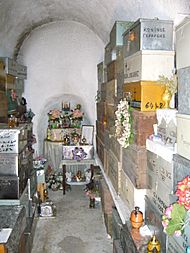Ossuary facts for kids
An ossuary is a special container or building where human skeletal remains (bones) are stored. People often use ossuaries when there isn't much space for burials.
Here's how it usually works: A body is first buried in a temporary grave. After some years, when the body has mostly turned into a skeleton, the bones are carefully removed. These bones are then placed in an ossuary. The word "ossuary" comes from "os," which means "bone" in Latin. Storing bones in an ossuary takes up much less room than burying bodies in coffins. This means many more people's remains can be kept in one place.
Contents
Ancient Ossuaries in Persia
In Persia, people who followed the Zoroastrian religion used deep wells as ossuaries about 3,000 years ago. They called these wells astudan, which means "the place for the bones." The Zoroastrian faith had many special rules and traditions for how these astudans were used.
Ossuaries in Christianity
Roman Catholic Ossuaries

You can find many ossuaries across Europe. Some famous ones include:
- The Santa Maria della Concezione dei Cappuccini in Rome, Italy.
- The Czermna Skull Chapel in Poland.
- The Capela dos Ossos ("Chapel of Bones") in Évora, Portugal.
- The Sedlec Ossuary in the Czech Republic, known for its artistic bone arrangements.
A more recent example is the Douaumont ossuary in France. It holds the remains of over 130,000 French and German soldiers who died during the Battle of Verdun in World War I. The Catacombs of Paris are also a very famous ossuary, located beneath the streets of Paris.
There's also an ossuary beneath the Monastery of San Francisco in Lima, Peru.
Eastern Orthodox Ossuaries

Using ossuaries is a long-standing tradition in the Orthodox Church. Orthodox Christians believe the body of a believer is a "temple of the Holy Spirit." This means the body is special and should be treated with great respect.
In Orthodox monasteries, when a monk dies, his body is buried for one to three years. After this time, the remains are dug up, cleaned, and placed in the monastery's charnel house (a building for bones). If people believe the person was a saint, their remains might be put in a special container called a reliquary. Otherwise, the bones are usually mixed together, with skulls in one area and long bones in another. The bones of an abbot (the head of a monastery) might be kept in a separate ossuary made of wood or metal.
Regular people in the Greek Orthodox Church also use ossuaries. After someone dies, they are buried for one to three years. Then, often on the anniversary of their death, the family and priest gather for a memorial service. After the service, the remains are dug up, washed with wine, perfumed, and placed in a small wooden or metal ossuary. This ossuary is marked with the person's name and kept in a special room, often near the church.
Jewish Ossuaries

During the Second Temple period (a long time ago), Jewish people had different ways of burying their dead, depending on their wealth and beliefs. Wealthy families sometimes used burial caves. First, the body would be placed in the cave. Later, the bones would be moved into smaller bone boxes called ossuaries. These ossuaries were then placed in small spaces within the burial caves or on benches.
Most of these ossuaries were made of limestone. About 40% of them were decorated with detailed patterns. Many ossuaries, whether plain or decorated, had inscriptions (writing) that identified the person inside. These inscriptions are very important for historians to learn about naming customs from that time.
Some well-known Jewish ossuaries from this period include:
- One found with the name 'Simon the Temple builder'.
- Another, 'Yehohanan ben Hagkol', which contained a nail in a heel bone, suggesting crucifixion.
- The 'James son of Joseph, brother of Jesus' ossuary, though its authenticity has been debated.
- Ten ossuaries found in the Talpiot Tomb in 1980, some with names mentioned in the New Testament.
Most of these ossuaries have been found in and around Jerusalem. However, some have also been discovered in Jericho.
Experts still discuss why and how ossuary burial started. Some believe it was due to new religious ideas about purity. Others think it was because wealthy people in Jerusalem and Jericho had more money and access to skilled stone workers, allowing for new burial styles. They might have also been influenced by Roman ideas about death.
The practice of using ossuaries for secondary burial generally did not continue among Jewish people after the Second Temple period. It also wasn't common for Jews outside the land of Israel. However, there were a few exceptions, like some clay ossuaries made in Galilee after the Second Temple was destroyed.
The World's Largest Ossuary
The Catacombs of Paris in France hold the skeletal remains of about six million people. These bones are neatly arranged in tunnels and pathways beneath the city streets. Paris has an estimated 300 kilometers (about 186 miles) of these underground passages. About 11,000 square meters (nearly three acres) are packed tightly with bones. These remains were moved from the city's overflowing cemeteries in the late 1700s.
Images for kids
-
Ossuaries from the Talpiot Tomb, displayed at the Israel Museum.
-
The Ursulakammer in the Basilica of St. Ursula in Cologne, Germany. In the 17th century, the largest mosaic ever made from human bones was created here, covering all four walls of the room.
See also
 In Spanish: Osario para niños
In Spanish: Osario para niños







